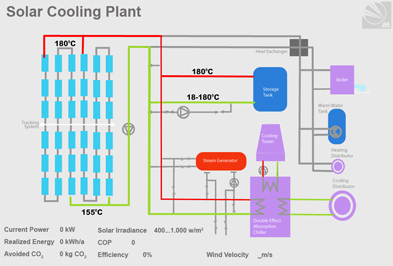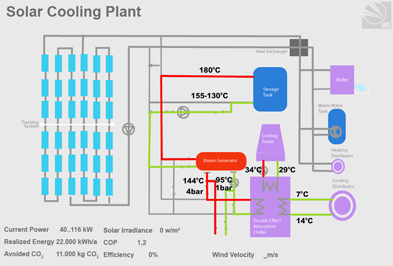 |
 |
Heating & Cooling. One of the most cost-effective measures in the planning of an air-conditioning system is the reduction of cooling loads already in the building planning and design phase, |
The demands for building cooling and air-conditioning is still rapidly increasing. The overall electricity demand for building air-conditioning in 2006 was estimated in germany to approx. 5% of the total electricity consumption (14% for the total of air-conditioning and refrigeration); in other Southern European countries this share might be far higher. This rising demand for cooling and air-conditioning in buildings involves unfavourable fossil fuel consumptions as well as upcoming stabiliIty problems in the electrictity supply in mediterraenean countries, which in turn demands for costly upgradings of the grids to handle electricity peak power demand situations. Thus, improved building concepts, targeting on reduction of cooling loads by passive and innovative measures, and the use of alternatives in coverage the remaining cooling demands of buildings, are of interest. Solar driven or assisted cooling is one of the possibilities to provide acively cold. Solar cooling or solar air-conditioning is used for solar thermally driven processes. Solar cooling in this sense may contribute to: • replacement of fossil fuel demand by use of solar heat and by this, contributing to the European policy targets on the increased use of renewable energies; • reduction of greenhouse effect emmissions through both, savings in primary energy and avoidance of environmental harmful refrigerants; • support in stability of electricity grids by less electrictiy energy and peakpower demand; • optimized use of solar thermal systems through use of solar heat for combined assistance of space heating, cooling and domestic hot water preparation. THE FUNDAMENTAL OF SOLAR COOLING Principles of desiccant-evaporative solar cooling. Air is a mixture of different gasses and water vapour. The change of air state can be a consequence of sensible heat transfer during the heating or cooling and the transfer of latent heat because of humidification or dehumidification. For that reason the state of the air should be expressed by internal energy called enthalpy (h) instead of air temperature. During the humidification of air, dispersed drops of water in the air, transforms into molecules of water vapour with assistance of internal energy of air. Consequently the air cools down. This kind of natural cooling is very efficient, although it has an side effect of increasing the air's moisture content and it's relative humidity, which can exceed the appropriate levels, defined by the thermal comfort. in conventional cooling systems air is dehumidified by cooling below the dew point, resulting in condensation of water vapour. The second option for drying the air is using special materials which have the ability of sorption removal of water vapour molecules out of the air. These materials are for example silica gel or lithium chloride. The first one is a solid, the second is a liquid; however, lithium chloride is also applied in impregnated structure, thus appearing as solid humidification of the material, which absorbs the water vapour from the air. When heating the sorption material above the temperature of 60 to 70oC the water vapour is released from it and the process can be repeated. In solar driven-evaporative solar cooling systems, this regeneration heat is provided by solar thermal collector system. In market available applications, the processes are combined with a heat recovery unit to the desiccant-evaporative solar cooling cycle. |
|


